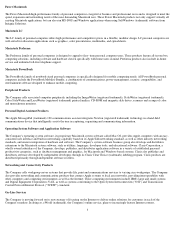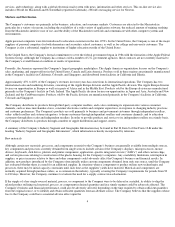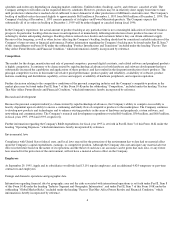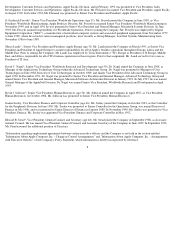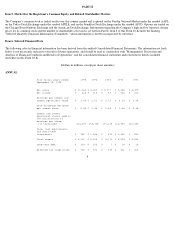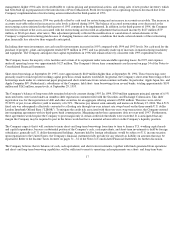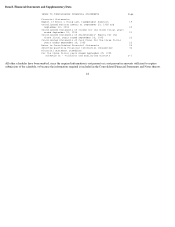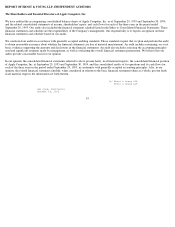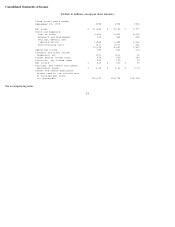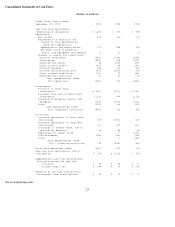Apple 1995 Annual Report Download - page 15
Download and view the complete annual report
Please find page 15 of the 1995 Apple annual report below. You can navigate through the pages in the report by either clicking on the pages listed below, or by using the keyword search tool below to find specific information within the annual report.In 1994, the Company introduced Power Macintosh, a new line of Macintosh computers based on a new PowerPC family of RISC
microprocessors. The Company's results of operations and financial condition may be adversely affected if it is unable to successfully complete
the transition of its lines of personal computers and servers from the Motorola 68000 series of microprocessors to the PowerPC microprocessor.
The success of this ongoing transition will depend on the Company's ability to continue to sell products based on the Motorola 68000 series of
microprocessors while continuing to gain market acceptance of the new PowerPC processor-based products, to successfully manage inventory
levels of both product lines simultaneously, and to continue to coordinate the timely development and distribution by independent software
vendors of new "native" software applications specifically designed for the PowerPC processor-based products.
The rate of product shipments immediately following introduction of a new product is not necessarily an indication of the future rate of
shipments for that product, which depends on many factors, some of which are not under the control of the Company. These factors may
include initial large purchases by a small segment of the user population that tends to purchase new technology prior to its acceptance by the
majority of users ("early adopters"); purchases in satisfaction of pent-up demand by users who anticipated new technology and as a result
deferred purchases of other products; and overordering by dealers who anticipate shortages due to the aforementioned factors. The preceding
may also be offset by other factors, such as the deferral of purchases by many users until new technology is accepted as "proven" and for which
commonly used software products are available; and the reduction of orders by dealers once they believe they can obtain sufficient supply of
product previously in backlog.
Backlog is often volatile after new product introductions due to the aforementioned demand factors, often increasing coincident with
introduction, and then decreasing once dealers and customers believe they can obtain sufficient supply of product.
The measurement of demand for newly introduced products is further complicated by the availability of different product configurations, which
may include various types of built-in peripherals and software. Configurations may also require certain localization (such as language) for
various markets and, as a result, demand in different geographic areas may be a function of the availability of third-party software in those
localized versions. For example, the availability of European- language versions of software products manufactured by U.S. producers may lag
behind the availability of U.S. versions by a quarter or more. This may result in lower initial demand for the Company's new products outside
the United States, even though localized versions of the Company's products may be available.
Competition
The personal computer industry is highly competitive and continues to be characterized by consolidations in the hardware and software
industries, aggressive pricing practices, and downward pressure on gross margins. For example, in Japan, other companies have begun to
initiate extreme competitive actions in order to gain market share, and as a result, the Company has implemented incremental pricing and
promotional activities. The Company's results of operations and financial condition could be adversely affected should the Company be unable
to effectively manage the impact of industrywide pricing pressures and downward pressures on gross margins.
The Company's future operating results and financial condition may also be affected by the Company's ability to offer customers competitive
technologies while effectively managing the impact on inventory levels and the potential for customer confusion created by product
proliferation. The Company's future operating results and financial condition may also be affected by overall demand for personal computers
and general customer preferences for one platform over another or one set of product features over another.
On November 7, 1994, the Company reached an agreement with IBM and Motorola, Inc. on a new hardware reference platform for the
PowerPC microprocessor that is intended to deliver a much wider range of operating system and application choices for computer customers.
As a result of this agreement, the Company is moving forward with its efforts to make the Macintosh operating system available on the
common platform. In line with its efforts, on November 13, 1995, the Company, IBM, and Motorola, Inc. announced the availability of the
"PowerPC Platform," which is a set of specifications that defines a "unified" personal computer architecture and combines the Power
Macintosh platform and the PC environment. Accordingly, the Company's future operating results and financial condition may be affected by
its ability to continue to implement this agreement and certain other collaboration agreements, and to manage the associated competitive risk.
The Company is currently the primary maker of hardware that uses the Macintosh operating system, and it has a minority market share in the
personal computer market, which is dominated by makers of computers that run the MS-DOS (registered trademark) and Microsoft Windows
(trademark) operating systems. The Company's future operating results and financial condition may be affected by its ability to increase market
share in its personal computer business. As part of its efforts to increase overall market share, the Company announced the licensing of the
Macintosh operating system to other personal computer vendors in January 1995, and several vendors currently sell product that utilize the
Macintosh operating system. The success of the Company's efforts to increase its overall market share through licensing of the Macintosh
operating system will depend in part on the Company's ability to manage the risks associated with competing with companies producing
Macintosh OS-based computer systems. Accordingly, the Company cannot determine
13


